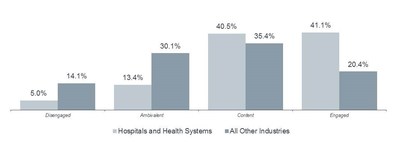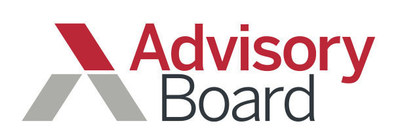|
19.09.2017 16:00:00
|
How Hospitals Can Shed Three Myths Hindering Employee Engagement
WASHINGTON, Sept. 19, 2017 /PRNewswire/ -- Hospitals and health systems can discard three myths of employee engagement to improve patient satisfaction and Medicare reimbursement and raise their image for patient safety with well-designed initiatives, according to the new report Data-Driven Insights for Your 2017 Employee Engagement Strategy, Advisory Board announced today.
"The latest data from hospitals working with Advisory Board on employee engagement show that institutions can throw away three traditional excuses for middling or lagging performance," said Sarah Rothenberger, Managing Director, Advisory Board Survey Solutions. "Improvement is possible from any starting point, and higher employee engagement correlates with stronger performance on patient satisfaction and culture of safety measures at the organization level."
The news is timely. "As hospitals and health systems undergo large change management initiatives around transitioning to value-based care and reducing unnecessary care variation, they should not overlook the role of employee engagement," said John Johnston, National Partner, Consulting at Advisory Board. "The data show the steps every organization can take to improve their own engagement and drive successful care transformation."
How employee engagement influences hospital performance and reimbursement
According to Advisory Board analysis, for every 1% increase in engagement, hospitals saw a 0.33-point improvement in Hospital Consumer Assessment of Healthcare Providers and Systems (HCAHPS) overall hospital rating. HCAHPS scores can impact hospitals' Medicare reimbursement by up to plus-or-minus 2% and may influence patient decisions in choosing a provider. The Centers for Medicare and Medicaid Services include HCAHPS in facility scoring on the Hospital Compare website that patients may consult in selecting providers.
Each 1% increase in engagement also correlated to a 0.41-point gain in Agency for Healthcare Research and Quality (AHRQ) Culture of Safety Patient Safety Grade, Advisory Board's analysis showed.
Engagement also influences hospital employees' performance. Engaged employees are 1.5 times more likely to receive top performance ratings than content employees and three times more likely to receive top performance ratings than disengaged employees.
The retention cost opportunity is just as clear. Disengaged staff are more than twice as likely as engaged staff to leave their organization in the 12 months following an employee engagement survey.
"Many health systems have been trying to address the critical challenge of turnover to improve organizational performance and at Parkview Health, one effective lever we have found is providing managers with a comprehensive onboarding toolkit," said Dena Jacquay, Chief Human Resources Officer at Parkview Health, a health system based in Fort Wayne, Indiana, that was named an Advisory Board Workplace of the Year for the second consecutive year in 2017. "Managers have responded to the toolkit because it gives them a significant head start. It also helps Parkview ensure that key milestones are handled consistently across the system."
What holds many hospitals and health systems back from realizing the benefits of improved employee engagement?
Myth 1: Many hospitals face insurmountable barriers to raising engagement
Hospitals should not assume that traditional demographic factors render poor engagement inevitable. For example, among organizations working with Advisory Board on employee engagement, institutions with a union presence averaged 45% engagement versus 43% for institutions that had no union presence. Facility type does show greater variation, with research and cancer centers showing the greatest opportunity to improve engagement.
Also, even strong performers can continue to improve. More than 44% of organizations starting above the mean engagement score improved, compared to 68% of those starting below the mean. Organizations that started with better-than-median employee engagement and saw gains in engagement saw an average increase of six percentage points.
Organizations that have already had an employee engagement initiative in place for more than a year can continue to generate sustained gains. Institutions beyond their first year of employee engagement work with Advisory Board saw faster gains—and higher overall engagement—than first-year organizations in 2016.
Myth 2: Hospitals should settle for engagement levels seen in other industries
Hospitals and health systems have a substantial engagement advantage over employers in other industries. For the vast majority of health care institutions, comparing to generic, multi-industry benchmarks will yield lackluster goals because the health care workers are already more than twice as engaged as employees in other industries. At the other end of the scale, the level of disengagement in other industries is three times that of the level within healthcare. Organizations looking to create accurate, ambitious goals should use healthcare-specific benchmarks down to the nursing unit level.
What does effective employee engagement look like? The 75th percentile benchmark for hospitals working with Advisory Board is nearly 50% employee engagement.

Myth 3: Some departments' engagement should be written off as hopeless
The biggest opportunity to boost engagement lies in targeting several of the largest clinical departments: laboratory, surgery, and nursing. These three departments are perennially among the least engaged groups. This need not be the case—other large, clinical departments such as imaging and rehab tend to have higher engagement levels. And several nursing unit types are outpacing the overall employee engagement national benchmark.
Advisory Board's Survey Solutions data include responses from more than 1 million respondents from hundreds of individual hospitals. Members of the programs average a 10% annual improvement in employee engagement. Hospitals and health system human resources leaders can download the reports Data-Driven Insights for Your 2017 Employee Engagement Strategy and The Manager's Guide to Engaging Staff.
About Advisory Board
Advisory Board is a best practices firm that uses a combination of research, technology, and consulting to improve the performance of 4,400+ health care organizations. As the health care business of The Advisory Board Company (NASDAQ: ABCO), Advisory Board forges and finds the best new ideas and proven practices from its network of thousands of leaders, then customizes and hardwires them into every level of member organizations, creating enduring value. For more information, visit www.advisory.com.

View original content with multimedia:http://www.prnewswire.com/news-releases/how-hospitals-can-shed-three-myths-hindering-employee-engagement-300521977.html
SOURCE The Advisory Board Company
 Der finanzen.at Ratgeber für Aktien!
Der finanzen.at Ratgeber für Aktien!
Wenn Sie mehr über das Thema Aktien erfahren wollen, finden Sie in unserem Ratgeber viele interessante Artikel dazu!
Jetzt informieren!
Nachrichten zu Advisory Board CoShsmehr Nachrichten
| Keine Nachrichten verfügbar. |